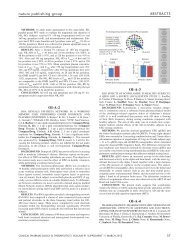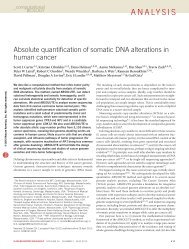open access: Nature Reviews: Key Advances in Medicine
open access: Nature Reviews: Key Advances in Medicine
open access: Nature Reviews: Key Advances in Medicine
Create successful ePaper yourself
Turn your PDF publications into a flip-book with our unique Google optimized e-Paper software.
BLADDER CANCER IN 2011<br />
The dawn of personalized medic<strong>in</strong>e<br />
Thomas W. Flaig and Dan Theodorescu<br />
Long awaited data from the cl<strong>in</strong>ical <strong>in</strong>vestigation of bladder cancer <strong>in</strong><br />
both the neoadjuvant and adjuvant sett<strong>in</strong>gs were released <strong>in</strong> 2011,<br />
sett<strong>in</strong>g the stage for the next generation of work <strong>in</strong> this area. The f<strong>in</strong>d<strong>in</strong>gs<br />
of a number of studies provide the first steps towards a personalized<br />
approach to this disease.<br />
Flaig, T. W. & Theodorescu, D. Nat. Rev. Urol. 9, 65–66 (2012); published onl<strong>in</strong>e 20 December 2011;<br />
doi:10.1038/nrurol.2011.220<br />
2011 was a year of progress <strong>in</strong> the field of<br />
bladder cancer. Efforts to set the context<br />
for more def<strong>in</strong>itive, practice-chang<strong>in</strong>g<br />
studies of targeted agents <strong>in</strong> bladder cancer<br />
were reported. Updated analysis of a large<br />
European phase III trial of neoadjuvant<br />
chemo therapy confirmed a significant<br />
survival advantage, and mutations that<br />
def<strong>in</strong>e potential drivers of disease, as well<br />
as a gene signature that predicts lymph node<br />
<strong>in</strong>volvement before cystectomy, are now<br />
available. Taken together, these advances<br />
make signifi cant strides <strong>in</strong> our understand<strong>in</strong>g<br />
of bladder cancer and beg<strong>in</strong> to pour<br />
the founda tion for a more personalized<br />
approach to the assessment and treatment<br />
of affected patients.<br />
Currently, no targeted therapies are utilized<br />
<strong>in</strong> the rout<strong>in</strong>e cl<strong>in</strong>ical care of advanced<br />
bladder cancer, and this is largely due to<br />
lack of study rather than negative results.<br />
Two notable studies published <strong>in</strong> 2011<br />
addressed this dearth of evidence. The<br />
importance of angiogenesis <strong>in</strong> oncogenesis<br />
is widely accepted and several antiangiogenic<br />
agents have been approved for cancer<br />
treatment <strong>in</strong> recent years. Precl<strong>in</strong>ical evidence<br />
<strong>in</strong>dicates that the vascular end othelial<br />
growth factor (VEGF) axis is important <strong>in</strong><br />
urothelial carc<strong>in</strong>oma, but there has been<br />
little cl<strong>in</strong>ical <strong>in</strong>vestigation of vascular <strong>in</strong>hibition<br />
<strong>in</strong> patients with urothelial cancer.<br />
This year, the Hoosier Oncology Group<br />
published a s<strong>in</strong>gle-arm, phase II study of<br />
a 21-day cisplat<strong>in</strong>– gemcitab<strong>in</strong>e regimen<br />
for advanced urothelial carc<strong>in</strong>oma with<br />
addition of the VEGF-directed antibody<br />
bevacizumab, <strong>in</strong> 43 patients. 1 The overall<br />
radiographic response rate was 72% (19%<br />
were complete responses), with a median<br />
overall survival of 19.1 months. Both of<br />
these outcomes are encourag<strong>in</strong>g and suggest<br />
improvement over historical series, <strong>in</strong><br />
which overall survival has ranged from 14<br />
to 18 months. Pulmonary embolism or deep<br />
ve<strong>in</strong> thrombosis was observed <strong>in</strong> 21% of<br />
the study cohort, prompt<strong>in</strong>g a dose reduction<br />
of gemcitab<strong>in</strong>e midway through the<br />
trial. The Cancer and Leukemia Group B is<br />
sponsor<strong>in</strong>g a randomized, phase III study<br />
of this regimen <strong>in</strong> patients with advanced<br />
uro thelial carc<strong>in</strong>oma (Cl<strong>in</strong>ical trials.gov<br />
identifier: NCT00942331).<br />
Add<strong>in</strong>g to our <strong>in</strong>sight of targeted therapy,<br />
a new understand<strong>in</strong>g of the mechanism of<br />
pulmonary metastasis <strong>in</strong> bladder cancer was<br />
described <strong>in</strong> 2011. Endothel<strong>in</strong>-1 (ET-1) is a<br />
vasoconstrictor, expression levels of which<br />
correlate positively with muscle <strong>in</strong>vasion<br />
and negatively with bladder cancer- specific<br />
survival. In new precl<strong>in</strong>ical f<strong>in</strong>d<strong>in</strong>gs, ET-1<br />
and its receptor were determ<strong>in</strong>ed to be<br />
neces sary for lung metastasis <strong>in</strong> bladder<br />
cancer, and this process was shown to be<br />
dependent on macrophage activity <strong>in</strong> the<br />
lung. 2 Importantly, pharmacologic <strong>in</strong>hibition<br />
of the ET-1 axis, us<strong>in</strong>g orally bioavailable<br />
ET-1 receptor <strong>in</strong>hibitors, prevented the<br />
development of lung metastases, but had<br />
little effect on established primary or metastatic<br />
tumors. Attempt<strong>in</strong>g to translate these<br />
f<strong>in</strong>d<strong>in</strong>gs <strong>in</strong>to a cl<strong>in</strong>ical context suggests that<br />
the use of ET-1 receptor <strong>in</strong>hibitors will be<br />
most efficacious <strong>in</strong> the adjuvant sett<strong>in</strong>g, not<br />
<strong>in</strong> the metastatic sett<strong>in</strong>g. This <strong>in</strong>formation<br />
may guide the future development of ET-1<br />
<strong>in</strong>hibitors for bladder cancer, given their<br />
availability and tolerability for chronic use.<br />
An important update to the large<br />
European phase III neoadjuvant chemotherapy<br />
trial was reported <strong>in</strong> 2011. 3 This trial<br />
<strong>in</strong>cluded patients with T2 grade 3, T3 or T4a<br />
bladder cancer (N0 M0) plann<strong>in</strong>g to undergo<br />
radical cystectomy or def<strong>in</strong>itive radiation<br />
therapy. A total of 976 patients were randomized<br />
to either three cycles of a 21-day cisplat<strong>in</strong>,<br />
methotrexate and v<strong>in</strong>blast<strong>in</strong>e (CMV)<br />
chemotherapy regimen or no chemotherapy<br />
before undergo<strong>in</strong>g cyst ectomy or radiation<br />
therapy. The <strong>in</strong>itial reports of this study <strong>in</strong><br />
1999 revealed a trend toward chemotherapy<br />
benefit that did not reach significance. In the<br />
© Orlando Flor<strong>in</strong> Rosu | Dreamstime.com<br />
UROLOGY<br />
updated report, there was a 16% reduction <strong>in</strong><br />
the risk of death and an absolute <strong>in</strong>crease <strong>in</strong><br />
the 10-year survival (from 30% to 36%) with<br />
CMV chemotherapy. Of note, the reduction<br />
<strong>in</strong> the risk of death was 26% <strong>in</strong> patients<br />
treated with cyst ectomy, which is compar able<br />
to that reported <strong>in</strong> the neo adjuvant f<strong>in</strong>d<strong>in</strong>gs<br />
with metho trexate, v<strong>in</strong>blast<strong>in</strong>e, doxorubic<strong>in</strong>,<br />
and cisplat<strong>in</strong> (MVAC) chemotherapy<br />
reported by SWOG. 4 Importantly, there is<br />
now evidence of a survival advantage with<br />
the use of neoadjuvant chemotherapy <strong>in</strong> two<br />
randomized, phase III studies, so a discussion<br />
of neo adjuvant chemotherapy should<br />
take place <strong>in</strong> all fit patients with muscle-<br />
<strong>in</strong>vasive disease prepar<strong>in</strong>g for def<strong>in</strong>itive local<br />
bladder cancer therapy.<br />
Despite these positive f<strong>in</strong>d<strong>in</strong>gs, which are<br />
based on pathological risk stratification, it<br />
is clear that the majority of patients treated<br />
with neoadjuvant chemotherapy do not<br />
benefit. A robust prognostic test is needed<br />
that would facilitate the use of chemotherapy<br />
<strong>in</strong> those at highest risk of recurrence, with<br />
a predictive test to select the therapy most<br />
likely to elicit a response <strong>in</strong> each patient.<br />
We did see some progress <strong>in</strong> the search for<br />
better prognostic markers for bladder cancer<br />
<strong>in</strong> 2011. In one new study, gene expression<br />
was assessed <strong>in</strong> three separate cystectomy<br />
cohorts and evaluated <strong>in</strong> the context of<br />
pathologic lymph node status at the time<br />
of surgery. 5 Two cohorts (<strong>in</strong>clud<strong>in</strong>g 90 and<br />
66 patients) were used as tra<strong>in</strong><strong>in</strong>g sets and a<br />
20-gene signature was developed, which was<br />
validated <strong>in</strong> a larger group (n = 185). Patients<br />
<strong>in</strong> the valida tion cohort were prospectively<br />
collected <strong>in</strong> an earlier cl<strong>in</strong>ical trial and analyzed<br />
retrospectively. The 20-gene expression<br />
model yielded an RR for the discovery<br />
of lymph node metastases of 1.74 <strong>in</strong> the<br />
desig nated ‘high-risk’ group compared to<br />
an RR of 0.70 <strong>in</strong> ‘low-risk’ patients, and was<br />
<strong>in</strong>dependent of stage and lymphovascular<br />
KEY ADVANCES IN MEDICINE JANUARY 2012 | S79








